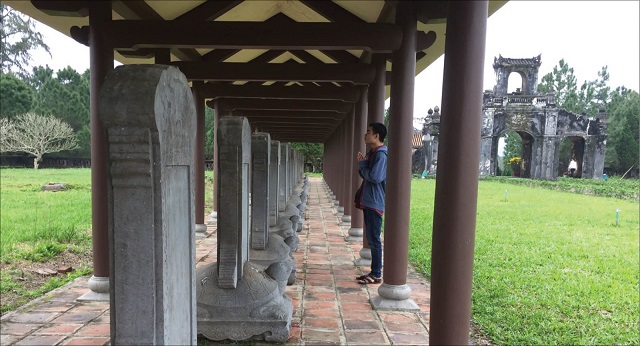
Visiting the Temple of Literature
During their 143-year-long reign, Nguyen Kings were very interested in studies and educational policies. As soon as Gia Long became King in 1802, in his first visit to Thang Long, he and his men discussed how to recover education and to train talented people for the country and prepared for Huong and Hoi examinations.
In the three years that followed, he invited talented and ethical men of the previous dynasties and experts to cooperate with the royal court to establish a stable administrative board. Many documents about examinations, talented people selection and studies at Van Mieu-Quoc Tu Giam signed by Emperor Gia Long can be found in the system of royal materials.
In terms of studying in the Nguyen Dynasty, the first construction that needs mentioning is Quoc Tu Giam, the royal college in Hue Capital City, one of the 20 landscapes in the capital city praised by Emperor Thieu Tri. Quoc Tu Giam was established first in 1076 in the Ly Dynasty. It is now located on the campus of the Temple of Literature in Ha Noi.
In early Nguyen Dynasty, after the country had been unified, Emperor Gia Long chose Hue to be the imperial capital and to establish a Quoc Tu Giam in Hue. At the beginning, it was small-scale, consisting of a main building in the center and two rows of rooms on both sides. It was then expanded and developed in Minh Mang’s and Tu Duc’s Eras.
Initially Quoc Tu Giam was located next to the Temple of Literature. Badly damaged many times due to natural disasters, in Duy Tan’s Era, Quoc Tu Giam was moved into the Citadel, at 23/8 Street now. Together with other monuments, Quoc Tu Giam, the only royal college of the feudal era that still exists now, has been recognized as part of the world cultural heritage.
Dr. Tran Dinh Hang suggests connecting the three monuments into a “golden triangle,” consisting of Di Luan Duong - Quoc Tu Giam, Tu Phuong Vo Su (Peace-in-Four-Directions Pavilion) and the Temple of Literature to form the tour of “Discovering Examinations in Ancient Hue” with many prominent traditional cultural values. The Temple of Literature was the place to honor people who passed exams, Di Luan Duong - Quoc Tu Giam was where the quintessence of laureates converged and Tu Phuong Vo Su was the place for princes and princesses being educated.
“On the second floor of Di Luan Duong, there is an altar worshipping master teachers. At the moment, this is not open to tourists to ensure the safety for the construction as well as a sacred place of worship. It will be great if this could be turned into a sacred place for praying for advance in studying,” said Dr. Tran Dinh Hang.
According to the plan agreed by Thua Thien-Hue People’s Committee, the History Museum will be moved to a new location and Quoc Tu Giam will be under the management of Hue Monuments Conservation Center. When it is done, Hue Monuments Conservation Center will be able to create services in accordance with the function of the building. Accordingly, turning Quoc Tu Giam into a museum about examinations to become the highlight for the tour “Discovering Examinations in Ancient Hue” is quite feasible.
“There should be divisions for such as history of exams, textbooks and materials, studying tools of different periods, souvenirs, etc. In order to be chosen, souvenirs must be unique and culture-bound. Suitable activities such as reproduction, performance, training, etc., should be noticed and promoted. Handicrafts or artifact reproduction must be high-class to be compatible with souvenirs about Hue royal court,” suggested Dr. Tran Dinh Hang.
At the moment, in Ha Noi, Vietnam National Museum of History is displaying some artifacts and photos about studies and examinations in the Nguyen Era such as: books, pens and ink, paper-holding bamboo pipes, book boxes for candidates, photos of Huong examinations in the Nguyen Dynasty, photos of the Temple of Literature in Hue, etc.
The museum has organized a separate exhibition called “Education in Vietnam, Periods 1802-1945” with 120 copies of materials, photos, technical drawings selected from royal materials of the Nguyen Dynasty and materials in French. The exhibition has attracted many visitors.
Every year before important examinations, many candidates spend time visiting Temple of Literature. It shows that in any era, studies and traditional educational values by themselves are always exciting.
In addition to the “golden triangle,” the ancient capital city of Hue boasts many other monuments that can be connected such as Thai Binh Pavilion, Nhat Thanh Pavilion, Thi Hoc Stele, Quoc Hoc High School, Bach cong - Ky nghe Thuc hanh (Professional School - Practical Industry School), Dong Khanh - Hai Ba Trung High School, Hue University, etc., to form diverse and original tourist services about education.
Story: Dong Van - Photo: Tue Ninh